Account Security Settings
Click 'Settings' > 'Settings' > 'Portal Set-up' then the 'Account Security' tab
-
This interface lets you configure security settings for admins that were created in Xcitium Enterprise itself ('Assets' > 'Users' > 'User List' > 'Create User').
-
You can configure to compel users to change their password periodically and use two-factor authentication.

Click the following links for more information about each setting:
Configure Password Expiry Setting
Click 'Settings' > 'Settings' > 'Portal Set-up' > 'Account Security' tab then the 'Edit' button at top-right
-
This area lets you enable password expiration policy for admins that were created in Xcitium itself ('Assets' > 'User Management' > 'User List' > 'Create User').
You can create roles which allow users to login to v if required. You can view and edit the privileges in each role at 'User Management' > 'Role Management'. Click here if you want help with roles.
The password expiration policy applies to Xcitium and Remote Control tool. See Remote Management of Windows and Mac OS Devices for details using RC tool.
This area does not implement password expiration policy for the account administrator who signed-up for the Xcitium Enterprise account.
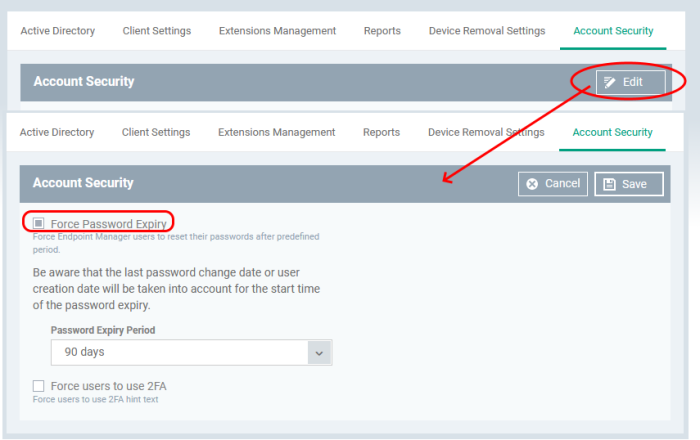
-
Force Password Expiry - Select this to enable password expiration policy
-
Password Expiry Period - Select the number of days after which the user is compelled to change his login Xcitium Enterprise login password.
Click 'Save' to apply your changes. Users will receive alerts during every login to Xcitium Enterprise and Remote Tool to change password from seven days before the expiry date.
Configure Two-factor Authentication Setting
Click 'Settings' > 'Settings' > 'Portal Set-up' > 'Account Security' tab then the 'Edit' button at top-right
-
Two-factor authentication adds additional security by requiring admins to present two forms of authentication before they can login to Xcitium. They will need to enter their regular UN/PW + a unique code generated on their mobile device.
-
This area lets you enable two-factor authentication (2FA) for admins that were created in Xcitium itself ('Assets' > 'User Management' > 'User List' > 'Create User').
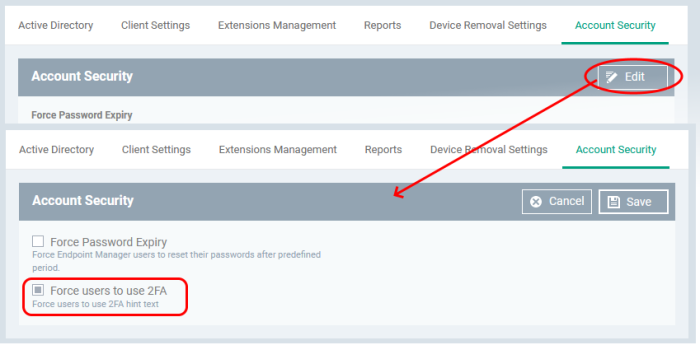
-
Force user to use 2FA - If enabled, admins will need to set-up 2FA on their next login to the Xcitium console. Setup involves installing the Google Authenticator app on their device. This app generates the codes that form the 2nd layer of authentication.
-
Click 'Save' to apply your changes
The following explains the admin user-experience to configure 2FA at first login:
-
Admin enters his/her UN/PW in the Xcitium login screen and clicks 'Login':
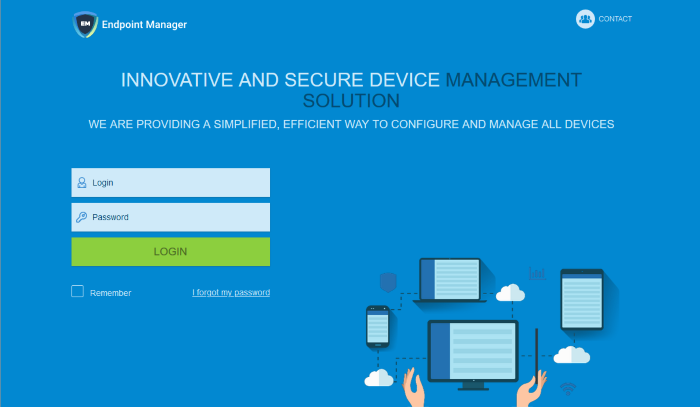
The two factor authentication activation screen is shown:
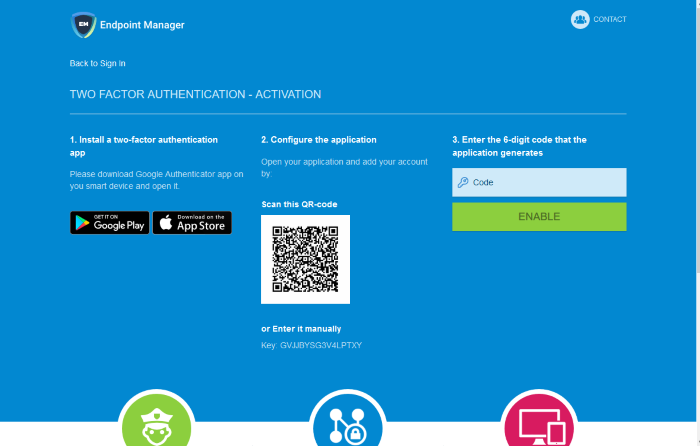
The admin needs to do the following:
-
Step 1 - Download the 'Google Authenticator' app and install it on your iOS or Android device
Open the 'Authenticator' app and tap the '+' icon
-
Step 2 - Scan the QR code with the device camera. This will cause the Google app to generate the six digit code you need to complete pairing.
Alternatively, enter the key shown below the QR code in the Google Authenticator app.
-
Step 3 - After completing steps 1 and 2, a six digit authentication code is generated in the Google app. This code changes frequently and is unique to their account.
Enter the verification code in the field provided
-
Click 'Enable'
-
A success message is shown along with 10 backup codes
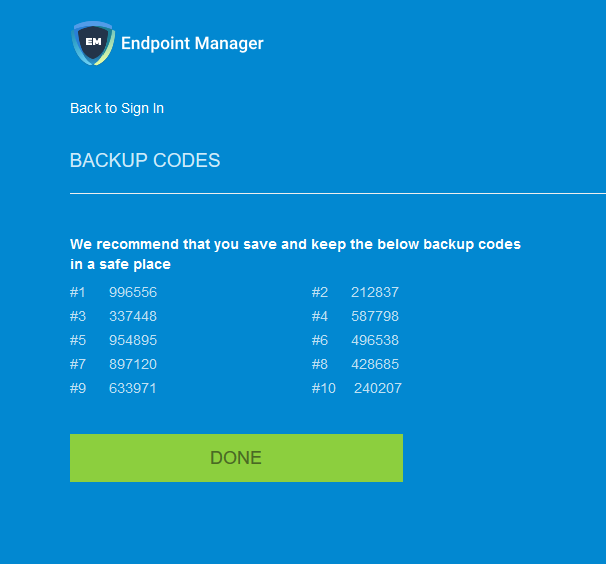
-
The admin can use the backup codes to complete two-factor authentication if they do not have the authentication device with them in future. Please make a copy of the codes. Each code can only be used once.
-
Click 'Done'. Admin will be logged in to your account.
Two-factor authentication is now configured.
-
During next login to Xcitium console, the two-factor authentication screen is shown after entering admin's username and password
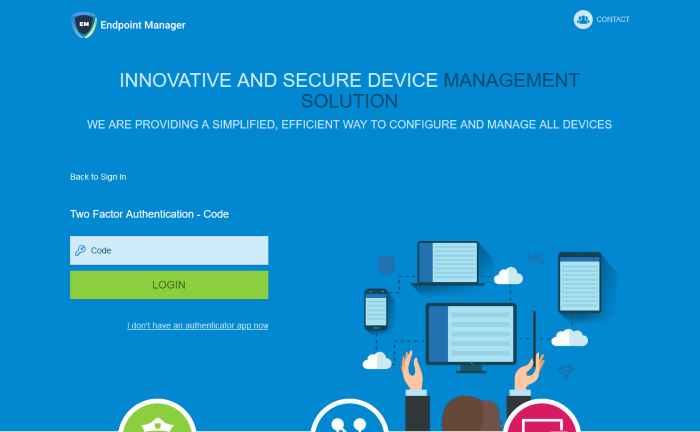
-
Code - Open the Google Authenticator app on your paired device and enter the displayed code. Please note the code changes frequently.
-
Click 'Login'
Use Backup Codes
Xcitium Enterprise two-factor authentication allows you to use your backup codes in case you do not have your paired device with you during a login attempt.
-
Click 'I don't have an authenticator app now' link
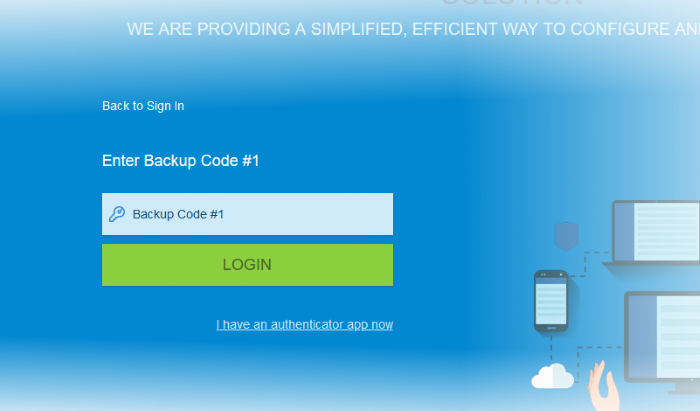
-
Enter backup code 1 from the saved backup codes when you paired your device
-
Click 'Login'
Disable Two-Factor Authentication
-
Individual admins cannot disable two-factor authentication on their own account as long as it is enabled by the account manager in Xcitium.
-
If 2FA is disabled by the account manager in Xcitium, then you can deactivate it after logging in to your Xcitium account.
-
Login to your account by providing credentials and 2FA code.
-
Click 'Settings' > 'Settings' > 'Portal Set-Up' then 'User Settings' tab.
-
Click 'Security Settings'.

-
Click 'Deactivate'
A confirmation dialog is shown:
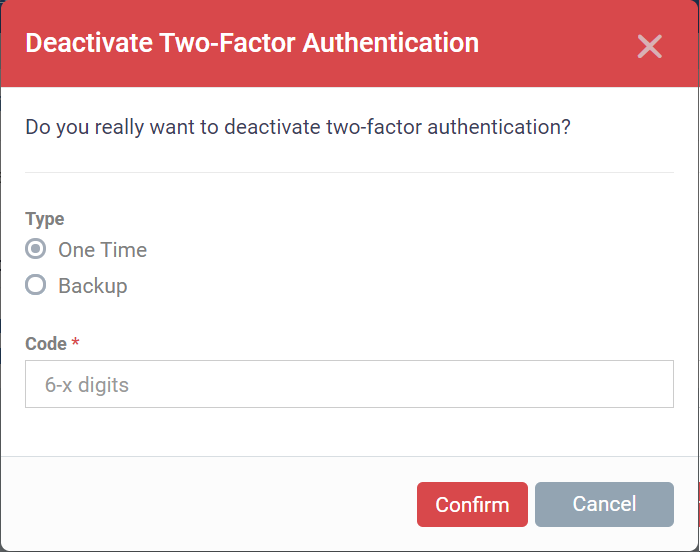
You can deactivate the two factor authentication in two ways:
-
Use the current authentication code - Select 'One Time', enter the current authentication code from your paired device and click 'Confirm'.
-
Use a backup code - Select 'Backup', enter anyone of your backup authentication codes generated when you were setting up your two factor authentication and click 'Confirm'.
Two Factor Authentication Activation by Admins
If 2FA is not enabled by your account manager in Xcitium, you can enable it for yourself as follows:
-
Login to your Xcitium account
-
Click 'Settings' > 'Settings' > 'Portal Set-Up' then the 'User Settings' tab
-
Click 'Security Settings'
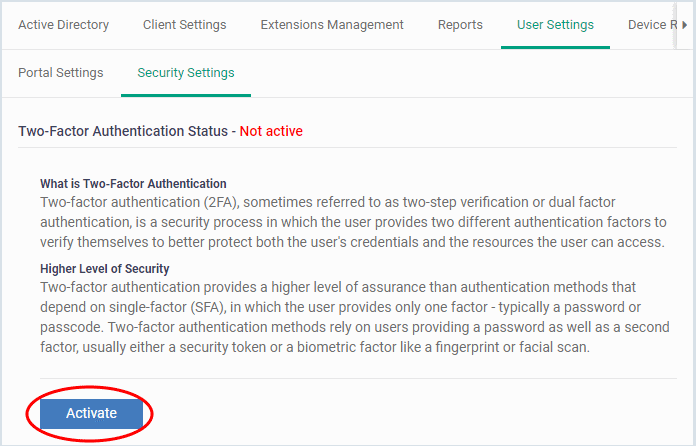
-
Click 'Activate'
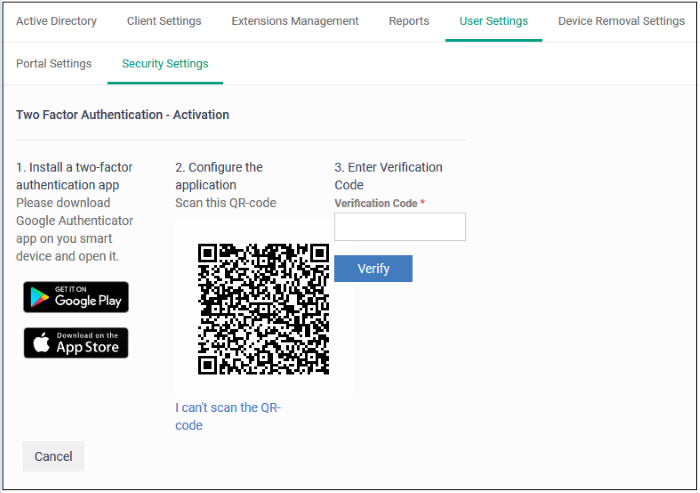
-
The device pairing procedure is similar as explained in the section above.



